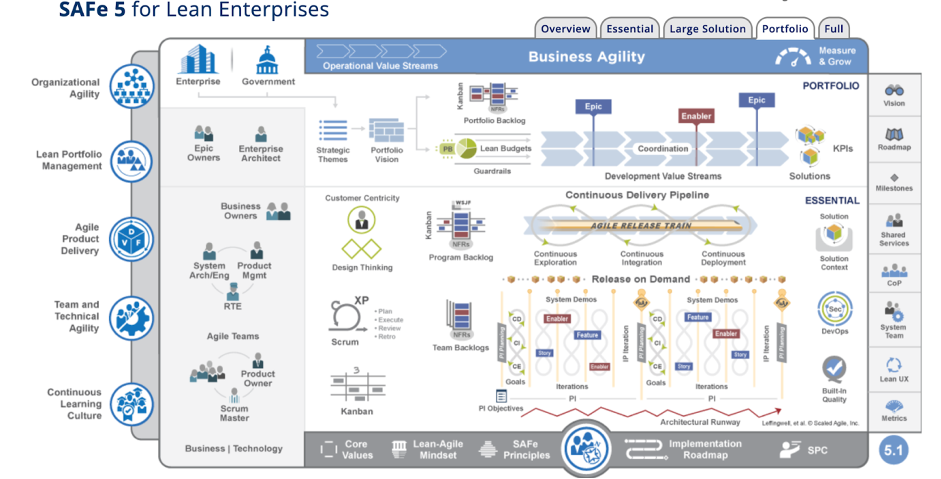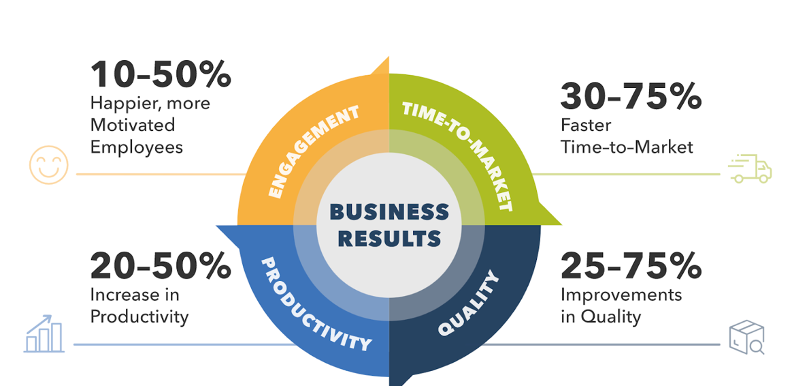SAFe(Scaled Agile Framework) is generally used for the entire organization where business agility is the key factor and where multiple agile teams are involved in developing and delivering successful products.
What is “Business Agility”?
In the current digital era, organizations should be comfortable adopting digital technologies to enhance current business models. In short, an organization’s capability to quickly adapt to the changing market needs and deliver a successful product refers to business agility.

Scaled Agile Framework(SAFe) is one of the leading frameworks in the world to achieve business agility. SAFe is a powerful combination of the below:
- Lean Agile -A guiding mindset that facilitates efficiency, effectiveness, and continuous improvement of a solution. Identifies redundant approaches and refines processes.
- Devops - provides the enterprise the ability to define, build, test and release innovative products to the business or customers.
Enterprises use SAFe framework to thrive in the digital age by developing and delivering innovative products with faster services and high quality.
The below diagram shows one of the configurations of SAFe:

As an example of business agility, consider that with COVID-19, there was uncertainty about the future of many working sectors , IT sector being the primary one. The sector had to adapt to latest technology and digital processes in order to recover and thrive during the pandemic and make sure that business could thrive.
Let’s talk about “Best practices for implementing SAFe”.
A lot of organizations report that implementing SAFe has been one of the toughest and most rewarding change initiatives that they have ever done.
Here are a few key factors that drive successful implementation of SAFe in an organization.
-
Training and ART(Agile Release Train) Teams
For an organization to successfully integrate SAFe, we must understand and reinforce its values to all the members of the organization starting from the management/leadership level. For this we need to have a team known as “change agents” that will train/coach the team members about the benefits of implementing SAFe for organizational effectiveness, improvement, and development.
Ultimately, it is the mindset that needs to be changed to transform the existing managerial framework and infrastructure to an agile framework for leading enterprises.
The implementation of the SAFe always begins with Agile Release Train (ART) which consists of multiple agile teams. The Agile teams are cross-functional, self-organizing, and self-managing. Typically, an agile team consists of 5 - 10 skilled individuals who are trained to produce a functional, testable solution through valuable incrementation.
The Scrum Master and the Product Owner help in the functioning of agile teams.
ART(Agile Release Train)- is the combination of multiple small agile teams and are made up of 50 to 125 people. ARTs are built on enterprise’s major Development Value Streams. Their sole purpose is to achieve that promised development value by building solutions that make a positive difference in the lives of the customers. The ART sync ups are coordinated by the RTE(release train engineers). -
Following the cadence
Cadence is the duration of the events that are conducted in ARTs which in turn creates a pattern for the team to understand what they are doing and when they will be done with it. The cadence can be up to two weeks for the team, while for the ARTs it can stretch up to 8-12 weeks.
For example, the cadence for the Daily Stand up call is 15 min every day. Similarly we have cadence defined for other SAFe ceremonies( mentioned as point 3) as well.
Cadence is required for the entire development process, creating predictability, and focusing constantly on the evolution. To summarize, the main purpose of applying cadence is to eliminate any kind of late discovery issues and problems during the development of solutions. -
SAFe Ceremonies
Program Increment (PI) Planning is the most important part of the SAFe. It is quoted that if teams are not doing PI Planning, they are not doing SAFe. PI Planning is essentially a cadence-based event in which all the teams of ART get together where the mission and vision is shared. PI Planning is an event organized at the train level by the release train engineer for 2-days. The main goal of PI Planning is to provide the teams a stage on which they can share, collaborate, plan, discover, and resolve issues quickly that could have taken several months.
In other words, PI Planning is the heartbeat of the Agile Release Train, and should be properly planned and executed at the project level.
Iteration Planning - Conducted every two weeks with the entire agile team. The meeting should not be more than an hour. Outcomes of the meeting include resolving any upcoming issues, reviewing any changes required for sprint, and committing work for the next 2 weeks.
Stand-Up –The daily meeting which captures the progress of the iteration. The team members provide the updates, raise the impediments and discuss the possible solutions to rectify the issues.
Iteration Review - At the end of an iteration, it’s common to review the work the team has finished. During this meeting, the team can demonstrate the work that they accomplished during the last sprint. This is where the stakeholders give feedback before the developed functionality is finally delivered to the customer.
Iteration Retrospect -This is where the team discusses what went well and what they could improve on. An important ceremony, this one focuses on opportunities to identify improvements for the team from a process and people perspective.
ART Sync Up Meetings - This meeting is conducted between various agile teams of the release train to discuss the ongoing progress of each team and resolve any impediments that are identified within the project. -
Customer Centricity, DevOps, and Release on Demand
Customer Centricity- The organization should develop innovative products keeping customer as the centre of the product strategy.
DevOps is the combination of Developers and Operational Teams, and helps to reduce the stress between the teams. SAFe introduces DevOps, an approach that sets forth practical technical practices.
To know more about Devops refer the site -
https://www.encora.com/insights/increase-productivity-with-devops-culture#1.%C2%A0%C2%A0%C2%A0-deployment-frequency
Release on Demand- is the process of deploying new functionality into production and releasing it incrementally based on the business decisions. -
Inspect and Adapt
Inspect and Adapt is an important part of the framework designed to guide organizations in scaling Lean and Agile development practices.
Thoroughly inspecting and improving both product and process typically translates into a better upcoming PI and process.
Benefits of SAFe for organizations.
As per the SAFe website and the case studies that were conducted , below is a representation of advantages of SAFe.

- Employees are happier and more motivated while working with SAFe. This generally results in a good quality product and ultimately satisfied and happy customers.
- Faster Time to Market - It is the amount of time taken for developing and delivering the product into market. , This is one of the biggest benefit of SAFe implementation.
- Increase in Productivity - SAFe empowers high-performing teams and teams of teams to eliminate unnecessary work, identify and remove delays, continuously improve, and ensure they are building the right things.
- Improvements in Quality - SAFe highlights the importance of integrating quality into every step of the development cycle.
Key Takeaways
To conclude, I would like to mention that no transformation is easy, and doesn't happen overnight.
The organization needs to make sure that team members are motivated and driven to accept the change. By implementing SAFe in an orderly fashion and following the best practices the organization would be in a better position to cater to the constantly changing needs of the customer.
Note - There are multiple flavours of Safe. In this blog, I have taken “Essential SAFe” into consideration.
About Encora
Fast-growing tech companies partner with Encora to outsource product development and drive growth. Contact us to learn more about our software engineering capabilities.
Resource List
- https://www.scaledagileframework.com/#
- https://dzone.com/articles/top-10-key-elements-for-successful-safe-implementa-1
- http://dz2prod01.cloud.answerhub.com/articles/top-10-key-elements-for-successful-safe-implementa-1